 A gripping and very engaging horror comic that updates a classic horror story format and presentation with tremendous skill and confidence. The stunning cover is a true indication of the wonderful quality of thwe work on the inside. Babies are being found roasted alive in ovens while their parents are out and baby sitters are taking care of the children. There is no visible connection between any of the incidents. When a young woman heads out to her baby sitting job she assures her mother that she will be fine. It goes every bit (and more) as wrong as expected, it goes wrong in happily unexpected ways. The story twists and turns before its utterly satisfactory conclusion.
A gripping and very engaging horror comic that updates a classic horror story format and presentation with tremendous skill and confidence. The stunning cover is a true indication of the wonderful quality of thwe work on the inside. Babies are being found roasted alive in ovens while their parents are out and baby sitters are taking care of the children. There is no visible connection between any of the incidents. When a young woman heads out to her baby sitting job she assures her mother that she will be fine. It goes every bit (and more) as wrong as expected, it goes wrong in happily unexpected ways. The story twists and turns before its utterly satisfactory conclusion.What is striking about this story is the wonderful confidence of the creative team, they set themselves a significant creative problem and have solved it with flair and very strong attention to detail. The story structure works very well, the framing element sets the context for the story and sets up the reader for the rest of the story. The whole context for the story is firmly established and used with considerable force and effect by JoJo King in the story and after the story.
Maxin Mel's art is a joy to read, the way the panels are used to control the flow of the story is masterful. Moving into close ups and pulling out to wide angle scene they confidently guide the reader into the details and back to the dramatic reveals as is required. The cast are varied and full of personality. The time is taken to give the leads space to establish themselves as somebodies before the trouble erupts. The physical context of the house and the town are solid and and seedy, they ground the story as it takes flight and gives the physical action real impact. The detective in particular seems to have a life beyond the confines of the story, he has a weight of living and hard experience written on his bones and brings it to bear when it is needed.
Steve Benton's colours are simply stunning, they capture, articulate and amplify the nuances inherent in the art and writing so naturally that the atmosphere is nearly palpable. Darkness, internal and external, is captures with care, the action is always clear, the lighting subtle and dramatic.
Choosing an old fashioned style is always an artistic risk, styles are always part of their own context and they rarely translate well, they can be a distraction rather than an addition. In Urban Legends what the creators have done is to use the style as a springboard for their own vision and it works because there is a genuine spirit behind it. The old fashioned style is the overall suggestion, the comic is contemporary in every way, it uses the style because that is the correct one to deliver the story they want to tell.
Chief Wizard Note: This is a review copy very kindly sent by JoJo King, to get a copy of Urban Legend 1, which you should because really good comics from seriously talented creators are sovereign remedy for all of life's annoyances (major or minor) you can purchase it here, http://www.storenvy.com/







